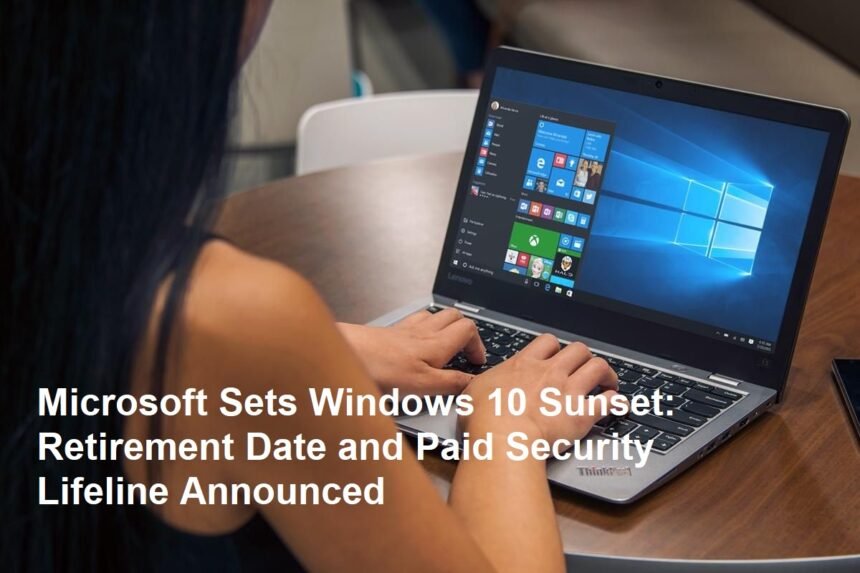Introducing
Marking the end of an era for one of its most popular operating systems, Microsoft has officially announced the retirement date for Windows 10 and detailed the Extended Security Updates (ESU) program that will offer a critical, albeit paid, lifeline for organizations needing more time to transition. This move signals the final countdown for the OS that powered billions of devices worldwide.
The Deadline: October 14, 2025
Microsoft has confirmed that October 14, 2025, will be the official end of support for Windows 10 (all editions, including Home and Pro). This means:
- No More Feature Updates:Development of new Windows 10 features ceases entirely.
- End of Free Security Patches:This is the most critical aspect. After this date, Microsoft will no longer provide free security updates, bug fixes, technical support, or online technical content updates for Windows 10. Unpatched systems will become increasingly vulnerable to new security threats and malware.
The Lifeline: Windows 10 Extended Security Updates (ESU)
Acknowledging that large-scale migrations take time, especially for enterprises and institutions, Microsoft is reviving its ESU program, previously used for Windows 7. This program provides a temporary extension of security updates only for Windows 10 devices that need to remain operational beyond the October 2025 deadline.
Key Details of the ESU Program:
- Paid Subscription:ESU is a paid annual subscription, per device. This is not a free extension.
- Target Audience:Primarily aimed at organizations – businesses, governments, educational institutions, and healthcare providers – managing large fleets of PCs where upgrading hardware or software en masse by late 2025 is impractical. While technically available to individual consumers, the per-device cost makes it largely impractical for home users.
- Duration:The ESU program will run for up to three years, through October 2028. However, Microsoft strongly emphasizes that this is a last resort, not an alternative to upgrading.
- What it Includes:Only critical and/or important security updates. It does not include new features, non-security updates, design changes, or technical support beyond security patches.
- Eligibility:ESU will be available for Windows 10 Pro, Enterprise, and Education editions. Windows 10 Home is not Devices must already be running Windows 10 version 22H2 to enroll.
- Pricing:Specific pricing hasn’t been released yet, but Microsoft stated it will follow a similar model to the Windows 7 ESU program. Costs typically increase significantly each year (e.g., Year 1 might be $X per device, Year 2 $2X, Year 3 $3X or $4X), reflecting the increasing risk and cost of supporting aging software. Volume licensing agreements will apply.
- Enrollment:Organizations will purchase ESU licenses through volume licensing channels (like VLSC) or via cloud solution providers. Enrollment mechanisms will be detailed closer to the program start.
Why This Matters: The Security Imperative
The end of free security updates is a major event. Running an unsupported OS is a severe security risk:
- Exploit Magnet:Hackers actively seek out unpatched vulnerabilities. Without updates, known security holes remain open doors for malware, ransomware, and data breaches.
- Compliance Failures:Many industries have strict regulations (like HIPAA, GDPR, PCI-DSS) requiring systems to be patched and supported. Running unsupported Windows 10 will violate these standards, potentially leading to fines and legal liability.
- Application & Hardware Incompatibility:Over time, new software and peripherals will increasingly drop support for Windows 10, limiting functionality.
Options for Users and Organizations:
- Upgrade Eligible Devices to Windows 11:This is Microsoft’s primary recommendation. Check hardware compatibility (TPM 2.0, specific CPU generation, Secure Boot). Many devices purchased since 2018/2019 can upgrade.
- Purchase New Hardware:For devices incompatible with Windows 11, replacing them with modern PCs pre-loaded with Windows 11 is the most secure and performant path forward.
- Enroll in ESU (For Organizations):A temporary, costly bridge for critical systems that cannot be upgraded or replaced before October 2025. Requires careful budgeting and a firm migration plan within the 3-year window.
- Accept the Risk (Not Recommended):Continuing to use Windows 10 without updates after October 2025 is highly dangerous, especially on internet-connected devices.
The Message is Clear: Plan Your Migration Now
Microsoft’s announcement removes any ambiguity. The clock is ticking towards October 14, 2025. For consumers, the path is clear: upgrade eligible PCs to Windows 11 or replace them. For organizations, the ESU program offers a vital, albeit expensive, respite, but it demands immediate action:
- Inventory:Identify all Windows 10 devices.
- Assess Compatibility:Determine which can upgrade to Win11, which need replacement.
- Budget:Plan for hardware refresh and/or ESU subscription costs.
- Timeline:Develop a concrete migration plan to be off Windows 10 (or onto ESU with an exit strategy) before the deadline.
- Communicate:Ensure stakeholders understand the risks and the plan.
The retirement of Windows 10 marks the sunset of a remarkably successful OS. However, the announcement of its end date and the ESU framework provides the necessary clarity for a managed and secure transition to the future of Windows. Ignoring this deadline is not an option for anyone concerned with security and stability.












